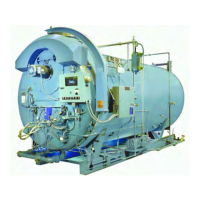Chapter 2 — Burner Operation and Control
2-6 Part No. 750-184
19.Program Relay and Flame Safeguard Control: Automatically
programs each starting, operating and shutdown period in
conjunction with operating limit and interlock devices. Includes,
in a timed and proper sequence, the operation of the blower
motor, ignition system, fuel valve(s), and the damper motor. The
sequence includes air purge periods prior to ignition and upon
burner shutdown.
The flame detector portion of the control monitors both oil and gas
flames and provides protection in the event of loss of a flame signal.
The control recycles automatically during normal operation, or
following a power interruption. It must be manually reset following
a safety shutdown caused by a loss of flame. An internal checking
circuit, effective on every start, prevents burner operation in the
event anything causes the flame relay to hold in during this period.
D. CONTROLS FOR GAS FIRING
See Figure 2-9. Depending upon the requirements of the insurance
carrier or other governing agencies, the gas flow control system
components may vary. Refer to the Dimension Diagram (DD)
prepared by Cleaver-Brooks for your specified installation.
1. Gas Pilot Valve: A solenoid valve that opens during the ignition period
to admit fuel to the pilot. It closes after main flame is established. The
sequence of energizing and de-energizing is controlled by the
programming relay. A second gas pilot valve may be required by
insurance regulations.
2. Gas Pilot Shutoff Cock: For manually opening or closing the gas supply
to gas pilot valve.
3. Gas Pressure Gauge: Indicates gas pressure to pilot.
4. Gas Pressure Regulating Valve: Reduces incoming gas pressure to suit
the pilot.
5. Main Gas Cock: For manually opening and closing the main fuel gas
supply downstream of the main gas line pressure regulator. A second
shutoff cock, downstream of the main gas valve(s), is installed to
provide a means of shutting off the gas line whenever a test is made for
leakage across the main gas valve.
6. Butterfly Gas Valve: The pivoted disc in the valve is actuated by
connecting linkage from the gas modulating cam to regulate the rate of
gas flow to the burner.
7. Main Gas Valves: Electrically actuated shutoff valves that open
simultaneously to admit gas to the burner. The downstream valve is
equipped with a “proof of closure” switch that is connected into the pre-
ignition interlock circuit.
8. Low Gas Pressure Switch: A pressure-actuated switch that is closed
whenever main gas line pressure is above a preselected pressure.
Should the pressure drop below the setting, the switch contacts open a
circuit causing the main gas valve(s) to close, or prevent the burner
from starting. The switch is usually equipped with a device that must
be manually reset after being tripped.
9. High Gas Pressure Switch: A pressure actuated switch that is closed
whenever main gas line pressure is below a preselected pressure.
Should the pressure rise above the setting, the switch contacts will
open a circuit causing the main gas valve(s) to close, or prevent the
burner from starting. The switch is usually equipped with a device that
must be manually reset after being tripped.

